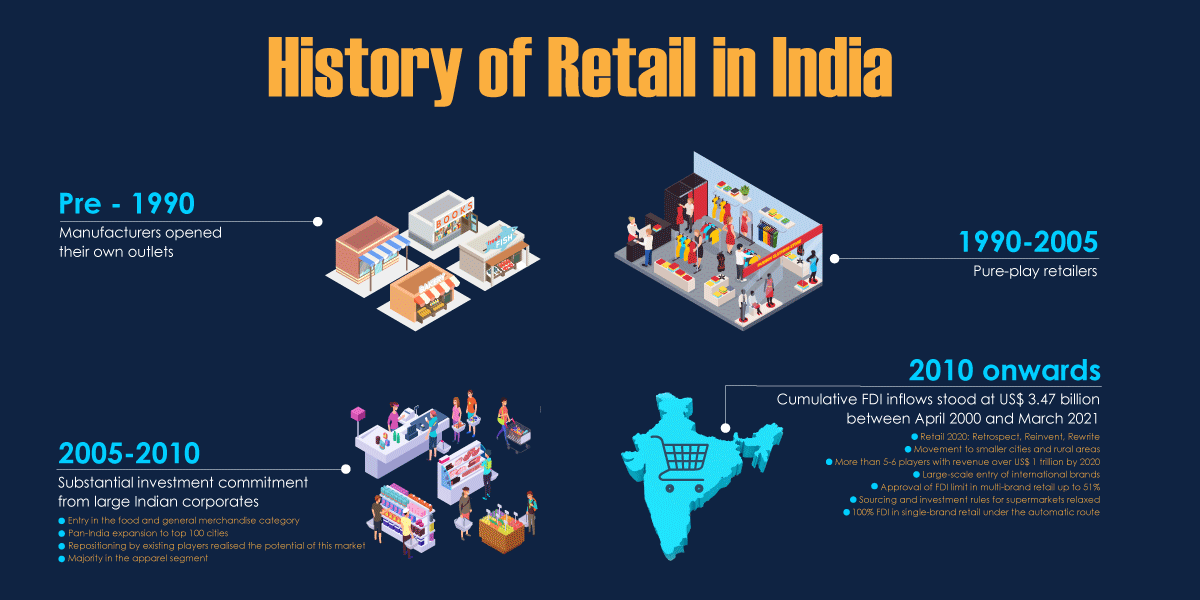Tale of New Retail : Evolution of Retail in India

Back in the day (Pre-1990), all we had were Kirana stores and storefronts that manufacturers would set up. The retail sector has grown exponentially. The tale of new retail is consistently evolving and here’s a snippet of our Retail Industry Whitepaper depicting exactly that

From an estimated $690 billion in 2021, Invest India predicts that by 2032 the size of the Indian retail industry will have grown to $2 trillion. NASCOM has released yet another study predicting a 25 million-person increase in employment within the retail sector in India. That’s a massive segment of the workforce, and it’s one that’s likely to keep changing as time goes on thanks to the emergence of new, specialised positions.
India has a sizable retail sector, but about 84% of it is unorganized
A large portion of India’s 1.3 billion people shop at unorganised retail establishments since they are convenient and familiar. When comparing India to other industrialised countries like the United States and the United Kingdom, India has the largest proportion of general trade. With almost 665,000 communities in Tier 2+, its secondary market is massive.
How’s the retail sector changing in India?
With the evolution of retailing in India, Retail brands are moving towards omnichannel and want to have more touchpoints with the customers. An omnichannel approach allows businesses to meet the demands of modern
consumers in every way. With the advent of omnichannel retailing, consumers now have multiple options for making purchases, including conducting research online and making a purchase in-store, making a purchase while in-store using a mobile device, and making a purchase while in-store using a mobile device and then purchasing a different variant of the same product online. It’s perfect for those who have trouble making decisions, are constantly on the go, appreciate high-tech gadgets, shop at malls, and surf the web late at night.
It’s a huge advantage for businesses to be able to keep tabs on their customers’ every move and have a 360-degree view. Brands can learn from customers’ complaints on one channel and their purchases on another by consolidating data from all channels. Customers’ desire for individualised care is met as a result of the company’s ability to proactively anticipate their requirements and meet them in a manner that is both timely and convenient. Customers appreciate the feeling of being appreciated and cared for in this way.
There is a greater demand than ever before for omnichannel retail. Due to the surge of online sales after the COVID-19 pandemic, it has become a vital component of any profitable retail and e-commerce enterprise.
Phygital refers to the trend of businesses merging the digital and physical worlds in an effort to create loyal customers.
An omnichannel approach that takes into account phygital channels is an excellent way to meet the needs of today’s consumers.
This financial hurdle may discourage brands who are hesitant to integrate phygital channels and omnichannel into their strategy, despite the enormous economic gains that can be realised by offering omnichannel experiences for customers and visitors.
It is expected that the adoption of the omnichannel strategy in retail will significantly increase the percentage of shoppers who make a purchase. Simply put, the more the number of conversion platforms you provide that work together, the greater your overall conversion rate will be. This will lead to gains in not only client retention but also brand lifetime value. If implemented properly, omnichannel retailing can significantly reduce overhead costs.
How would this growth in retail translate to jobs?
- With the festive season around the corner, hiring across e-commerce and retail is expected to grow by 30-40%, and according to our estimates, e-commerce businesses will add more than 5 lakh temporary jobs. Hiring is particularly strong in quick commerce, QSRs, retail stores, and FMCG.
- As per our estimates around 2 Lakh jobs are expected to be added by the end of this fiscal year in the retail sector alone
- With evolution of retailing in India, the omnichannel retailing is also evolving, allied industries, for example, 3PL, will employ a lot more to contain the demand. The total number is estimated to reach 8 Lakh by the end of 2022
- FOS (feet on street) and in-store promoters will be in high demand. In the retail industry, hiring for customer-facing roles in sales and commercial operations, as well as other departments, is picking up steam on the basis of increased demand and an optimistic forecast for the impending festive season.
Even though the retail industry has had a number of difficulties over the past two years, the pandemic has presented an opportunity for a long-overdue significant retail reset, which may inspire many stores to find a more secure and profitable footing. As a result of technological advancements, the retail industry has shifted its focus from products and locations to customers. Businesses are now better able to share information about discounts and inventories across all of their stores.
With the retail sector growing at an incredible rate, jobs in this sector and allied sectors are going to evolve, and niche roles catering to different segments in the market will come into the picture.
The future of Evolution of Retailing in India has seen its share of struggles and triumphs, but a new era is about to begin.
Latest Blogs
New Labour Code: A Workforce Wake-Up Call for India
For years, India’s labour ecosystem resembled a dusty filing closet, layered, confusing and waiting for someone brave enough to open it. The arrival of the...
Read More4 New Labour Codes: How Workers and Employers Benefit
Reforms shape the future only when they simplify the present. India’s new Labour Codes stand out as one of the most meaningful updates to the...
Read MoreEmployer of Record (EOR) Services: Hire in India
According to the International Monetary Fund (IMF), India remains the only major economy projected to grow above 6% in FY 2025, with a forecasted GDP...
Read MoreRPO vs Contract Staffing: Choosing the Right Talent Model
The Talent Dilemma: Balancing Long-Term and Short-Term Hiring Needs Priya, the HR Head of a fast-scaling Indian startup, faced a familiar challenge. Her company was...
Read MoreWhat Are the 3 New EPFO Withdrawal Rules? Explained Clearly
Social security isn’t about saving for retirement; it’s about staying secure through every stage of work.” The Employees’ Provident Fund Organisation (EPFO) has revamped its...
Read More





